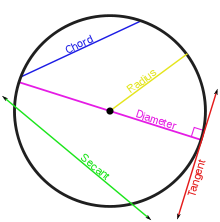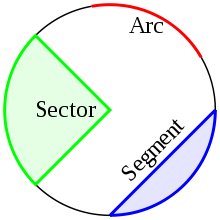The circle is a round plane figure whose boundary (the circumference) consists of points equidistant from a fixed point (the center). Reference: Oxford dictionary
Reference: wikipeda.org
Importance Of Continuity
In the case of the “Outer School” (which emphasizes attack) of boxing, the strength one exerts is still and the movements are not continuous, but are sometimes made off and on, which leaves opening the opponent may take advantage of. In taijiquan, one focuses the attention on the mind instead of force, and the movements from the begenning to the end are continuous and in an endless circle, just “like a river which flows on and on without end” or “like reeling the silk thread off cocoons”.
The Ten Essentials of Taijiquan by by Yang Cheng Fu (Recorded by Chen Wei Ming)
The central feature of the postures is the combination of an empty circle which has form and a formless circle which is full. These two circles represent the principle of the “empty” and “substantial.” Within the postures there is an apparent emptiness, but the posture is not really empty; it appears to be substantial, but there is in reality emptiness. This qi flows to all places without obstruction. It is rounded and lively without angles. It is without excesses or deficiencies. When manifest, the Six Harmonies are complete. When returning, it is hidden as a treasure within. Its changes are without limit. Its uses are inexhaustible. Herein lies the real teachings. It is the sum of Tai Ji Quan.
Chen Xin’s Boxing Treatise says it best, “When your practice is most refined, even the smallest place is circular” Every sphere has its center. Within the sphere that issues from this central pivot, there are no breaks, deficiencies, hollows or projections. So where can there be double weighting? There is a saying, “Adhering is moving away. Moving away is adhering.” The term “Taiji” actually means the center of a circle, where the outer portion is called yang and the inner portion yin [that is, outside the circle and inside the circle]. Yang is applied by adhering and attacking. Yin is applied by moving away and defending. Furthermore, adhering is preparation for moving away. and moving away is preparation for adhering. Thus, we can continue, “Yin does not depart from yang; yang does not depart from yin.” It can also be said, “Yin and yang balance each other; this is known as “comprehending energy” (dong jing). What is called “yin and yang, adhering, moving away, hard and soft, following” and so on are all words referring to attacking and defensive movements. Within the attack, there is defense, and within defense, there is an attack. For this reason, we speak of “mutual balance”. Recognizing this principle is equivalent to “comprehending energy”.
A Study of Taiji Push-Hands by Xiang Kairen
He could only give him advice on a few movements, like Single Whip (Dan Bian) and “Luo Lu” or circles made with the hands and waist in three different planes, to train how to change the hand position correctly in order to dissipate incoming force and strike simultaneously, but without using strength.
4 ounces deflects a 1000 pounds by Dong Bin
“Avoid turning circles without any purposes. Make sure that there is “yi” (mind/intent) in every one of your moves. You need to stand up and face your opponents and should not run away from them.”
“Do not treat push-hands lightly, thinking it involves only turning circles, some pushes and power discharge. We should treat it like fighting an enemy who is trying to kill us. Once we get in contact with his arms we should be able to control him, and we should not be controlled by him.”
Finer points of yiquan push-hands by Yao Cheng-rong
Ren Gang says that in push hands or sparring etc, one must first look upon the opponent not as a separate entity that you must defeat – The Enemy – but as a part of you, a part of your energy circle.
How to train your spirit and energy to drive the body by Ren Gang
Retreat in order to advance (Yi Tui Wei Jin).
In pushhands the feature of prime importance is to adapt and move with the changing conditions of your counterpart. The circular movements in Taichi are the image of the symbol of taichi, which is evolving, comprising the changes of moving and adhering within a circle.
The circular movements (Dong Zuo Zou Hu Xian).
The patterns of interchange between yin and yang are all based on circular movements and connected by ”sticking ” to the partner’s intension. Because there is no interruption in a circular movement, it is easier to reach the partner than in a forward or backward straight line. Another benefit is that it is easier to change your acting force or direction at any point of the circular line.
About the principles of wu-style taichichuan by Ma Jiangbao
Yi is responsible for relaxing the external body, the muscle; for storing the Qi one develops in practice, for making smaller circles and spirals, for condensing movement to small frame, and eventually to no visible movement in order to develop Nei Jing.
Therefore you only have to make the Light circulate: that is the deepest and most wonderful secret. The Light is easy to move, but difficult to fix. If it is allowed to go long enough in a circle, then it crystallizes itself: that is the natural spirit -body. This crystallized spirit is formed beyond the nine Heavens. It is the condition of which it is said in the Book of the Seal of the Heart: Silently in the morning thou fliest upward.
The Golden Flower by Master Lu Tzu
Sun Anguang

